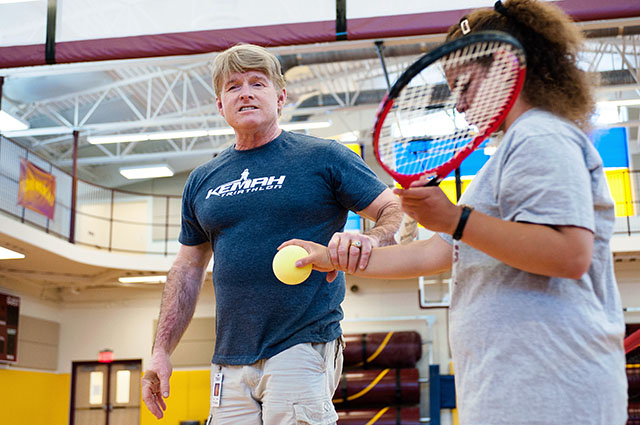Texas School for the Blind Sees a Future in Tennis

Joe Paschall, a coach at the Texas School for the Blind and Visually Impaired, guides a deafblind student to her position on the court. Photo by Daniel Regueira.
By Sebastian Herrera
For Reporting Texas
Joe Paschall was born with eyes that see a blurry world, but he envisions a big and bright future in tennis for the blind.
Paschall, who is visually impaired, has taught sports for two decades at the Texas School for the Blind and Visually Impaired in Austin. He has coached students there to embrace sports such as wrestling, track and field, swimming and, since 2011, tennis.
He and the United States Tennis Association brought adaptive tennis to the school as a way to introduce students to a new sport. Paschall hopes the sport can be formalized in time for the 2020 Summer Paralympics in Tokyo, in the country where adapted tennis began.
“We’re in the evolution of this (sport) right now,” Paschall said. “We have an activity now that has the potential to get to some really big places. That’s what we’re hoping for and working towards.”
Tennis for the blind originated in 1984, when blind Japanese high school student Miyoshi Takei invented the first adaptive tennis ball, a design still in use. Each ball has an outer shell of dense foam, while the core is like a large ping-pong ball filled with metal beads.
The balls jingle when they bounce off the floor, giving blind and visually impaired players the ability to track them.
The net is lower than in standard tennis, and fault and out of bound lines are marked with string, so players can feel them.
The school’s adaptive tennis was conceived by former USTA Texas adaptive tennis coordinator Todd Carlson, and his successor, Cindy Benzon.
They wanted to extend their reach to visually impaired individuals after hearing of schools for the blind in Japan, which have had their own version of tennis since the creation of the adaptive ball there.
At the time the Texas School of the Blind introduced blind tennis, programs were also beginning in schools for the blind in New York, Boston and California. The USTA also started to sponsor other adaptive forms of the sport, such as wheelchair tennis.
“None of us had ever attempted to do anything with the blind,” Benzon said. “We knew it was out there, so we brainstormed a way to do that with the kids, and what kind of programs to do.”
Benzon said that the school’s location was the closest to USTA’s Texas headquarters in Houston, so the fit seemed right for the program.
Soon, Carlson and Benzon began working with Paschall. The School for the Blind began using the help of the American Printing House for the Blind, which supplies adaptive tennis kits. The kits, which the school still uses, consist of regular tennis rackets with the adaptive balls.
“The students are using all of their other senses besides their vision,” Paschall said. “They get a lot out of playing and challenging themselves like that.”
The School for the Blind has approximately 150 students, who range from toddlers to 22 years old. They come from all parts of the state and most live at the school, where they attend classes and participate in other activities, just as students in pubic schools do. Their levels of visual impairment vary.
According to Kristine Seljenes, an assistant physical education teacher at the school, the learning process for adaptive tennis usually begins in middle school. For each individual, Saljenes said, the process is different, depending on their impairment.
“For some of my students, I might teach them to hit the ball over the net,” said Saljenes, who has worked at the school for 10 years. “For other students, that might not be appropriate. They might need to have the ball attached to the racket by a string and hit it like that, because they might have even more difficulty seeing it. It varies.”
Physically feeling what certain tennis terms mean gives students an understanding of traditional tennis. When listening to a match on television, students who have been through the tennis lessons can now imagine what the commentators are describing. This, Saljenes explained, is the bigger picture of teaching the sport.
Besides adapted kickball, tennis is the newest sport at the school.
The goal for USTA and the School for the Blind is to develop enough research so the adaptive sport can keep growing. There are no formal leagues or competitions yet.
“It takes a lot of research, a lot of trial and error when working with the kids,” Paschall said. “That is where you find out what works. I work with the kids and try to learn what I can use and not use with them. That is what I am going to learn this summer – how to better teach it.”